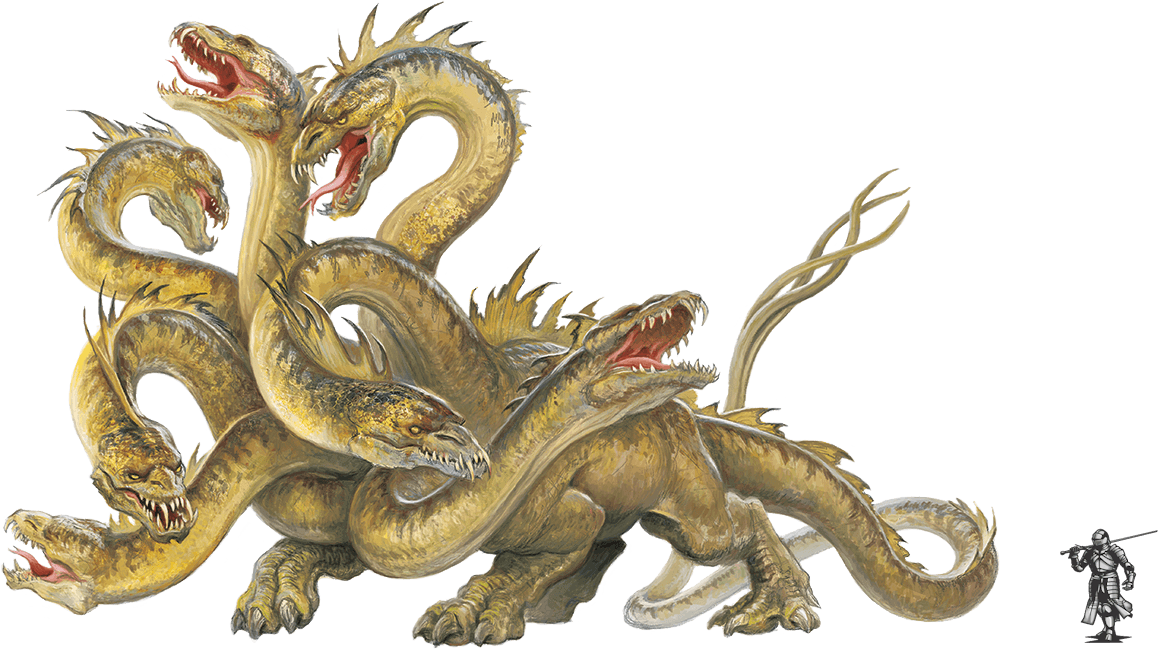


Not only does an adult 7-headed hydra have damage reduction, but it also regenerates. On any round in which a head was severed (requires hitting AC -3 and dealing at least 10 damage slashing) during the previous round, two new heads will sprout in place of it — unless the decapitating strike also dealt at least one point of fire damage, or, alternatively, a spell or torch inflicted at least three points of fire damage or acid damage on the neck stump in the preceding round.
Regardless of whether a head takes sufficient slashing damage to be severed, subtract any damage a head takes from the hydra's hit point total. If two heads sprout in place of a severed head, add +20 HP to the hydra's hit point total. This can result in total hit points exceeding the original HP total at the beginning of the encounter. If this +20 HP takes the hydra to a hit point total greater than its starting HP, make a note of the new max HP.
If the hydra doesn't gain any heads in a given round, then it instead regenerates a number of HP equal to the total number of heads it currently possesses — to a maximum of twelve.
Adult hydras are extremely smart, and may elect to use one of their heads to inflict a bite attack that automatically severs another head as long as the attack roll isn't a fumble. When using this trick, the hydra will typically do this just before a new combat round begins. A seven-headed hydra is 75% likely to perform this trick at the very beginning of combat, hoping to quickly gain the advantage of having eight heads after heads sprout in round two.
If at 9+ heads and 100+ HP, the hydra is only 50% likely to bite off one of its own heads; but if in any round it has either fewer than 9 heads or fewer than 100 HP, it's 60% likely to do so. The likelihood of a hydra using this trick when it has 11+ heads is only 25% each round.
An adult hydra with seven or more heads has resistance to bludgeoning and piercing attacks, but not to slashing attacks. When the DM applies resistance to piercing or bludgeoning weapons, she should be sure to do so after the
If a hydra has 7+ heads, any bite attack that scores a hit and inflicts 10+ damage will also require a DC 15 Dexterity saving throw. Failure indicates the target is violently shaken by that hydra neck/head (like a dog will shake a snake), suffering an addition 2d4 damage before being slung away by the powerful neck, where it lands and takes another 2d4 damage from impact. This means that at seven heads, a bite victim is going to suffer a minimum of 7d4, and possibly 11d4.
An adult hydra has Reach with each neck/head, and can target adjacent foes as well as those that are ten and fifteen feet away.
When an adult hydra loses a head, one of the remaining heads automatically reacts by spewing forth a cloud of noxious gas that fills a cube which encompasses the hydra and all spaces out to twenty feet from it. Anyone caught in that area of effect must make a DC 17 saving throw (Con based) or sustain temporary partial blindness and coughing that cause all die rolls by the character to be made at a penalty of four for the remainder of the encounter. On a successful saving throw, eyes water and coughing still ensues, and the victim suffers a -2 penalty to all rolls for the remainder of the encounter. A thief with Improved Evasion may be able to escape this attack form entirely.
At the beginning of any combat round in which a hydra posseses more than seven heads, it gains an additional point of DR for every two heads beyond seven. So, if nine heads DR would improve to 4/-; if thirteen heads, DR 6/-. This effect maxes out at DR 10/-.
An adult hydra dies when its HP are less than one at the beginning of a round (before it would normally regenerate HP or sprout heads), or when all of its heads have been severed.
The total XP award for slaying an adult hydra is equal to the sum of:
(a) 6,600
(b) the total points of damage the hydra inflicted in the combat
(c) 200 * (max heads hydra had during combat)